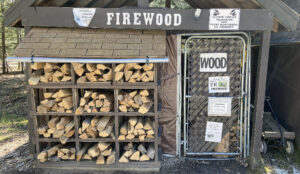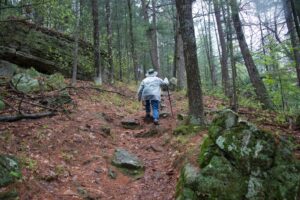
Don’t move firewood! Many State Parks and Forests stock firewood right at the campground entrances. Use these stands or other local sources that are no more than 10 miles from your destination to avoid spreading invasive species. / Photo Credit: Wisconsin DNR
Erika Segerson-Mueller, DNR Invasive Plant Program Specialist, Oshkosh Service Center;
Erika.Segersonmueller@wisconsin.gov or 715-492-0391
Whether you prefer to enjoy Wisconsin’s beautiful fall weather on a hike, bike, ATV/UTV or on the water, the Wisconsin Department of Natural Resources (DNR) urges those enjoying the outdoors to take a few precautions to avoid bringing invasive plant species along for the ride.
The Wisconsin Council on Forestry has created a set of guidelines titled “Invasive Species Best Management Practices for Outdoor Recreation.” These voluntary guidelines include steps recommended for individuals to minimize the inadvertent spread of invasive species.
Here are a few universal Best Management Practices (BMPs) for outdoor recreation, along with a few examples of these practices in action.
-

Whether you recreate on foot, tire, watercraft or motor, take a few precautions to avoid bringing invasive plants along for the ride. / Photo Credit: Rena Johnson, National Association of State Foresters
Learn to recognize invasive species common to the areas where you enjoy outdoor recreational activities.
Suggested activities:
- Check out the DNR pages on species regulated under NR40 (Wisconsin’s invasive species rule that makes it illegal to possess, transport, transfer, or introduce certain invasive species.)
- Carry A Field Guide to Invasive Plants in Wisconsin to identify plants you find while recreating.
-
Inspect and clean hair, clothing, footwear and gear for soils, seeds, plant parts or invertebrates before and after recreating.
Suggested activities:
- If present, use a mounted boot brush station to remove seeds from your shoes before and after using a trail or recreational area.
- Carry a handheld boot brush for use on clothing and pets. Brush off all dirt and mud and remove any seeds or burrs before moving locations.
-
Stay on designated trails, roads and other developed areas.
Suggested activities:
- When in doubt, stay out: Avoid any on- or off-trail areas that appear to be infested with invasive species.
-
Report infestations of invasive species to the appropriate land manager or property owner.
Suggested activities:
- Note the location – take a photo, note the GPS coordinates and/or map the infestation if you are able.
- Report invasive species sightings on public lands to species@wisconsin.gov. Please include a location description and photos of the plant, pest or pathogen.
-
Volunteer to help control invasive species or spread the word by educating others about invasive species and their effect on our environment, economy and recreational opportunities.
Suggested activities:
- Check your area to see if a CISMA (Cooperative Invasive Species Management Area) exists and join them. CISMAs work in a specific area to manage invasive plants and provide outreach and education.
After a day on some of Wisconsin’s best trails or waterways while following these BMPs, you might plan to kick back around the campfire and consume one (or five) s’mores. Remember that moving firewood can provide a major pathway for invasive plants, pests and diseases. By using local and/or certified firewood, you can avoid bringing harmful problems to new locations.
Buy it where you plan to burn it: Purchase your firewood no more than 10 miles from your destination and don’t carry any unused wood home with you. Firewood Scout can help you find local firewood for sale.
Learn more about invasive species and how to avoid moving them around, and read all of Wisconsin Council on Forestry’s Invasive Species Best Management Practices in the full manual on their webpage.
